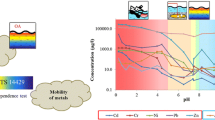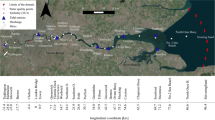Abstract
The potential leaching of pollutants present in harbor sediments has to be evaluated in order to choose the best practices for managing them. Little is known about the speciation and mobility of heavy metals in these specific solid materials. The objective of this paper is to determine and model the leachability of copper, lead, and zinc present in harbor sediments in order to obtain essential new data. The mobility of inorganic contaminants in a polluted harbor sediment collected in France was investigated as a function of physicochemical conditions. The investigation relied mainly on the use of leaching tests performed in combination with mineralogical analysis and thermodynamic modeling using PHREEQC. The modeling phase was dedicated to both confirm the hypothesis formulated to explain the experimental results and improve the determination of the main physico-chemical parameters governing mobility. The experimental results and modeling showed that the release of copper, lead, and zinc is very low with deionized water which is due to the stability of the associated solid phases (organic matter, carbonate minerals, and/or iron sulfides) at natural slightly basic conditions. However, increased mobilization is observed under pH values below 6.0 and above 10.0. This methodology helped to consistently obtain the geochemical parameters governing the mobility of the contaminants studied.


Similar content being viewed by others
References
Acquavita A, Predonzani S, Mattassi G, Rossin P, Tamberlich F, Falomo J, Valic I (2010) Heavy metal contents and distribution in coastal sediments of the Gulf of Trieste (Northern Adriatic Sea, Italy). Water Air Soil Poll 211:95–111
Association Française de NORmalisation (AFNOR) (1996) Qualité des sols—Sols, sédiments—Mise en solution totale par attaque acide, NF X31-147. AFNOR Editions, Paris
Botté SE, Freije RH, Marcovecchio JE (2010) Distribution of several heavy metals in tidal flats sediments within Bahia Blanca estuary (Argentina). Water Air Soil Poll 210:371–388
Brennan EW, Lindsay WL (1996) The role of pyrite in controlling metal ion activities in highly reduced soils. Geochim Cosmochim Ac 60:3609–3618
Brown GE, Calas G (2011) Environmental mineralogy—understanding element behavior in ecosystems. CR Geosciences 343:90–112. doi:10.1016/j.crte.2010.12.005
Buruaem LM, Hortellani MA, Sarkis JE, Costa-Lotufo LV, Abessa DMS (2012) Contamination of port zone sediments by metals from large marine ecosystems of Brazil. Mar Poll Bull 64:479–488. doi:10.1016/j.marpolbul.2012.01.017
Caille N, Tiffreau C, Leyval C, Morel JL (2003) Solubility of metals in an anoxic sediment during prolonged aeration. Sci Tot Environ 301:239–250
Cambier P (1991) Modélisation des phénomènes d’adsorption des solutés sur les surfaces minérales. Synthèse bibliographique. Science du sol 29:245–264
Caplat C, Texier H, Barillier D, Lelievre C (2005) Heavy metals mobility in harbour contaminated sediments: the case of Port-en-Bessin. Mar Pollut Bull 50:504–511
Carman CMI, Xiang-Dong L, Gan Z, Onyx WHW, Yok-Sheung L (2007) Trace metal distribution in sediments of the Pearl River Estuary and the surrounding coastal area, South China. Environ Poll 147:311–323. doi:10.1016/j.envpol.2006.06.028
Casado-Martínez MC, Buceta JL, Belzunce MJ, DelValls TA (2006) Using sediment quality guidelines for dredged material management in commercial ports from Spain. Environ Int 32:388–396
Casado-Martínez MC, Forja JM, DelValls TA (2009) A multivariate assessment of sediment contamination in dredged materials from Spanish ports. J Hazard Mater 163:1353–1359
Cassi R, Tolosa I, Mora SD (2008) A survey of antifoulants in sediments from ports and marinas along the French Mediterranean coast. Mar Pollut Bull 56:1943–1948
Chatain V, Sanchez F, Bayard R, Moszkowicz P, Gourdon R (2005) Effect of experimentally induced reducing conditions on the mobility of arsenic from a mining soil. J Hazard Mat 122:119–128
Delolme C, Hébrard-Labit C, Spadini L, Gaudet JP (2004) Experimental study and modeling of the transfer of zinc in a low reactive sand column in the presence of acetate. J Cont Hydrol 70:205–224
Drahota P, Filippi M (2009) Secondary arsenic minerals in the environment: A review. Environ Int 35:1243–1255
Dzombak DA, Morel FMM (1990) Surface complexation modelling—hydrous ferric oxide. John Wiley & sons, New york
European Council, (2002). Council decision of 19 December 2002 establishing criteria and procedures for the acceptance of waste at landfills pursuant to Article 16 of Annex II to directive 1999/31/EC(2003/33/EC). Off J Eur Communities L11/27 (16.01.03)
Förstner U (1995) Non linear release of metals from aquatic sediments. In: Salomons W, Stigliani A (eds) Biogeodynamics of pollutants in soils and sediments. Springer Verlag, Berlin, pp 247–307
French Official Journal (2000) J.O.No. 184 (10 August 2000) 12415 (NOR: ATEE0090254A)
Grosdemange D, Leveque F, Drousie D, Aqua JL, Mehu J, Bazin C (2008) The SEDIMARD project: presentation and results. In: International symposium on sediment management (I2SM). Lille, France
Guevara-Riba A, Sahuquillo A, Rubio R, Rauret G (2004) Assessment of metal mobility in dredged harbour sediments from Barcelona, Spain. Sci Tot Environ 321:241–255. doi:10.1016/j.scitotenv.2003.08.021
Huerta-Diaz MA, Tessier A, Carignan R (1998) Geochemistry of trace metals associated with reduced sulfur in freshwater sediments. Appl Geochem 13:213–233
Isaure MP, Laboudigue A, Manceau A, Sarret G, Tiffreau C, Trocellier P, Lamble G, Hazemann JL, Chateigner D (2002) Quantitative Zn speciation in a contaminated dredged sediment by μ-PIXE, μ-SXRF, EXAFS spectroscopy and principal component analysis. Geochim Cosmochim Ac 66:1549–1567
Kosson DS, Van der Sloot HA, Sanchez F, Garrabrants AC (2002) An integrated framework for evaluating leaching in waste management and utilization of secondary materials. Environ Eng Sci 19:159–204
Mamindy-Pajany Y, Géret F, Roméo M, Hurel C, Marmier N (2012) Ex situ remediation of contaminated sediments using mineral additives: assessment of pollutant bioavailability with the Microtox solid phase test. Chemosphere 86:1112–1116
Manceau A, Matynia A (2010) The nature of copper bonding to natural organic matter. Geochim Cosmochim Ac 74:2556–2580
Martínez-Lladó X, Gibert O, Martí V, Díez S, Romo J, Bayona JM, de Pablo J (2007) Distribution of polycyclic aromatic hydrocarbons (PAHs) and tributyltin (TBT) in Barcelona harbour sediments and their impact on benthic communities. Environ Pollut 149:104–113
Merdy P, Gharbi LT, Lucas Y (2009) Pb, Cu and Cr interactions with soil: sorption experiments and modeling. Colloids and surfaces A: physicochem. Eng Aspects 347:192–199
Morillo J, Usero J, Gracia I (2004) Heavy metal distribution in marine sediments from the southwest coast of Spain. Chemosphere 55:431–442
Morse JW, Luther GM (1999) Chemical influences on trace metal-sulfide interactions in anoxic sediments. Geochim Cosmochim Ac 63:3373–3378
Parkhurst DL, Appelo CAJ (1999) User’s guide to phreeqC (version 2)—a computer program for speciation, batch-reaction, one-dimensional transport, and inverse geochemical calculations. Denver, Colorado
Perrodin Y, Donguy G, Pandard P Andres S (2012) Guide méthodologique pour l’évaluation des risques écologiques liés à la restauration de carrières de la zone littorale à l’aide de sédiments de dragage portuaires prétraités. Programme ANR « SEDIGEST » TOME 1 Présentation de la méthodologie. 62 p. (URL:http://www.sedigest.org/documents/Sedigest_Guide_pour_EDR_Ecologiques.pdf)
Peyronnard O, Blanc D, Benzaazoua M, Moskowicz P (2009) Study of mineralogy and leaching behavior of stabilized/solidified sludge using differential acid neutralization analysis. Part II: use of numerical simulation as an aid tool for cementitious hydrates identification. Cement Concrete Res 39:501–509
Quevauviller P, Rauret G, López-Sánchez JF, Rubiob R, Urec A, Muntaud H (1997) Certification of trace metal extractable contents in a sediment reference material (CRM 601) following a three-step sequential extraction procedure. Sci Tot Environ 205:223–234
Sakellari A, Plavšić M, Karavoltos S, Dassenakis M, Scoullos M (2011) Assessment of copper, cadmium and zinc remobilization in Mediterranean marine coastal sediments. Estuar Coast Shelf S 91:1–12
Shi J, Carman CM, Zhang G, Jiang G, Li X (2010) Mercury profiles in sediments of the Pearl River Estuary and the surrounding coastal area of South China. Environ Poll 158:1974–1979
Sundaray SK, Nayak BB, Lin S, Bhatta D (2011) Geochemical speciation and risk assessment of heavy metals in the river estuarine sediments—a case study: Mahanadi basin, India. J Hazard Mat 186:1837–1846
Tessier A, Campbell PGC, Bisson M (1979) Sequential extraction procedure for the speciation of particulated metals. Anal Chem 51:844–851
Tessier E, Garnier C, Mullot JU, Lenoble V, Arnaud M, Raynaud M, Mounier S (2011) Study of the spatial and historical distribution of sediment inorganic contamination in the Toulon bay (France). Mar Pollut Bull 62:2075–2086
US Environmental Protection Agency/US Army Corps of Engineers (1992) Evaluating environmental effects of dredged material management alternatives—a technical framework. EPA-842-B-92-008. Office of Water, Washington
Usero J, Gamero M, Morillo J, Gracia I (1998) Comparative study of three sequential extraction procedures for metals in marine sediments. Environ Int 24:487–496
Van der Sloot HA, Van Zomeren A, Djikstra JJ, Meussen JCL, Comans RNJ, Scharf H (2005) Prediction of the leaching behaviour of waste mixture by chemical speciation modelling based on a limited set of key parameters, 2005 ECN RX 05–164 ECN
Vane CH, Harrison I, Kim AW, Moss-Hayes V, Vickers BP, Horton BP (2008) Status of organic pollutants in surface sediments of Barnegat Bay-Little Egg Harbor Estuary, New Jersey, USA. Mar Pollut Bull 56:1802–1814
Yap CK, Ismail A, Tan SG, Omar H (2002) Concentrations of Cu and Pb in the offshore and intertidal sediments of the west coast of Peninsular Malaysia. Environ Int 28:467–479
Acknowledgments
The research presented in this paper was funded by the French National Research Agency (ANR, France). The authors are grateful to EEDEMS (French Research Network on Waste and Polluted Materials Management) and POLDEN (French Applied Research and Consultancy Team on environment, waste, and polluted materials management) for providing experimental support.
Author information
Authors and Affiliations
Corresponding author
Additional information
Responsible editor: Zhihong Xu
Rights and permissions
About this article
Cite this article
Chatain, V., Blanc, D., Borschneck, D. et al. Determining the experimental leachability of copper, lead, and zinc in a harbor sediment and modeling. Environ Sci Pollut Res 20, 66–74 (2013). https://doi.org/10.1007/s11356-012-1233-1
Received:
Accepted:
Published:
Issue Date:
DOI: https://doi.org/10.1007/s11356-012-1233-1




